The Nannostomus marginatus, also known as the Dwarf Pencilfish, is an incredibly captivating species that fascinates fish enthusiasts worldwide. This fish is part of the prestigious Lebiasinidae family, renowned for its exceptional pencilfish species.
Table of Contents
One fun fact about the Dwarf Pencilfish is that they are named after their small size and pencil-like shape. The scientific name Nannostomus marginatus means “small mouth” (Nannostomus) and “bordered” (marginatus), referring to the dark stripe along their body.
In the wild, Dwarf Pencilfish live in South America, specifically in the Amazon River basin. They prefer slow-moving waters with plenty of plants to hide in. These fish are mid-dwellers, meaning they spend most of their time in the middle of the water column.
When it comes to their diet, Dwarf Pencilfish are omnivores. They eat small insects, crustaceans, and plant matter in the wild. In an aquarium setting, they will happily accept high-quality flake or pellet food, along with occasional treats like brine shrimp or daphnia.
Dwarf Pencilfish are generally peaceful and make great tank mates for other small, non-aggressive fish. They do best in groups of at least six, as they are schooling fish. It’s essential to keep them in a tank with plenty of hiding spots and a gentle current.
One interesting study published in the Journal of Fish Biology found that Dwarf Pencilfish have a unique social structure. The researchers discovered that these fish form stable hierarchies within their schools, with dominant individuals leading the group.
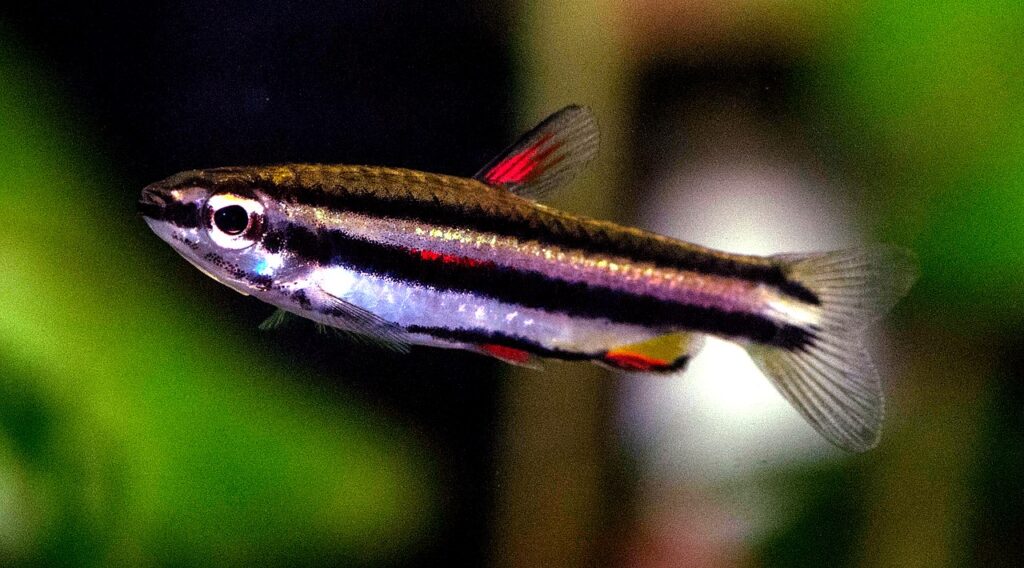
Dwarf Pencilfish Key Information
Dwarf Pencilfish (Nannostomus marginatus) are small, colorful fish that make a stunning addition to any peaceful community aquarium. Their slender, elongated bodies are adorned with a striking golden-brown stripe running from their eye to the base of their caudal fin, contrasting beautifully with their pale, translucent bodies. The fins of these tiny fish are often tinted with red, adding to their overall appeal.
| Family | Lebiasinidae |
| Origin | South America (Amazon River Basin) |
| Price | $2 – $5 per fish |
| Common Names | Dwarf Pencilfish, Dagger Fish |
| Variants | N/A |
| Ideal Tank Size | 10 gallons or larger |
| Water Parameters | Temperature: 72-79°F (22-26°C), pH: 6.0-7.5, Hardness: 2-12 dGH |
| Lifespan | 3-5 years |
| Full Size | 1.5-2 inches (3.8-5 cm) |
| Natural Environment | Slow-moving streams and rivers with dense vegetation |
| Behavior | Peaceful, schooling fish |
| Habitat Preference | Mid-water to top levels |
| Aquarium Decoration | Densely planted with open swimming areas |
| Ideal Tank Mates | Other peaceful, small fish (e.g., tetras, rasboras, small catfish) |
| Fish to Avoid | Large, aggressive fish that may view them as prey |
| Best Foods/Diet | High-quality flake or pellet food, supplemented with frozen or live foods (e.g., brine shrimp, daphnia) |
| Disease | Susceptible to common aquarium diseases if water quality is poor |
| Sex-Switch | No |
| Gender Differences | Difficult to distinguish, females may be slightly larger and more rounded |
| Care Level | Easy |
| Breeding Level | Moderate – requires soft, acidic water and fine-leaved plants for spawning |
Ideal Tank Mates for Dwarf Pencilfish
Choosing suitable tank mates for the Dwarf Pencilfish is vital in creating a serene and harmonious aquarium. It is important to select companions that share similar temperaments, water requirements, and swimming behaviors. Here, we present ten exceptional fellow occupants for the Dwarf Pencilfish, along with detailed explanations of their compatibility, ensuring a tranquil and well-balanced aquatic environment.
1. Neon Tetras (Paracheirodon innesi)
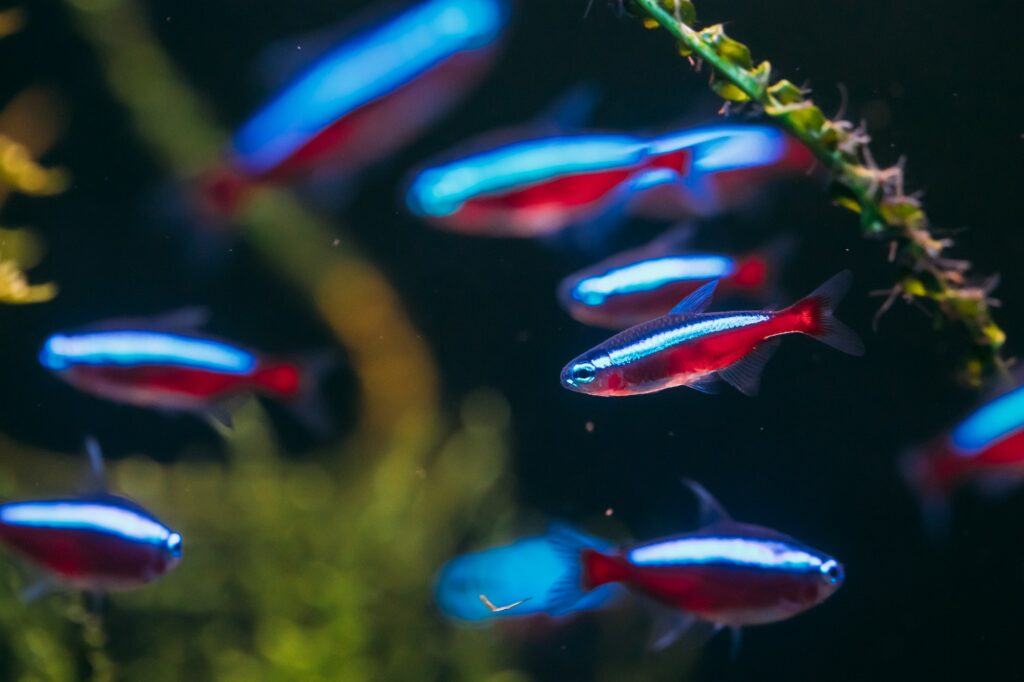
Neon Tetras are a classic choice for community tanks, and they make fantastic tank mates for Dwarf Pencilfish. Both species thrive in similar water conditions and enjoy the company of their own kind. Neon Tetras are peaceful, active, and add a vibrant pop of color to the aquarium.
| Common/Market Names | Neon Tetra |
| Price Range | $1 – $3 per fish |
| Care Level | Easy |
| Behavior | Peaceful, schooling |
| Life Span | 5-8 years |
| Max Size | 1.5 inches (3.8 cm) |
2. Cherry Barbs (Puntius titteya)
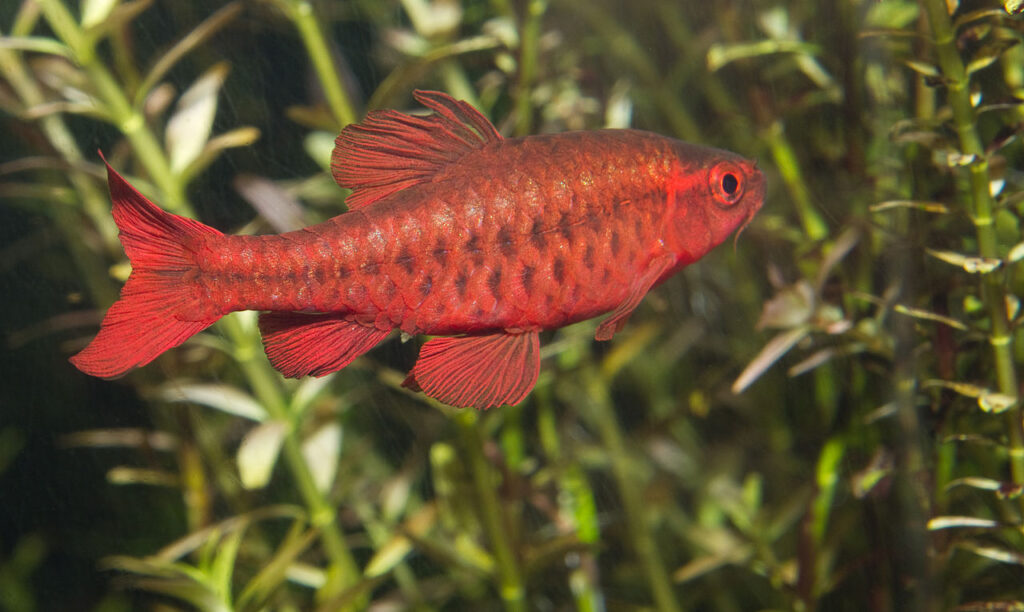
Cherry Barbs are another excellent choice for Dwarf Pencilfish tank mates. These small, colorful fish are peaceful and active, spending most of their time in the middle and upper levels of the aquarium. Cherry Barbs are easy to care for and adapt well to a variety of water conditions.
| Common/Market Names | Cherry Barb |
| Price Range | $2 – $4 per fish |
| Care Level | Easy |
| Behavior | Peaceful, active |
| Life Span | 4-6 years |
| Max Size | 2 inches (5 cm) |
3. Harlequin Rasboras (Trigonostigma heteromorpha)

Harlequin Rasboras are a stunning addition to any community tank and make great companions for Dwarf Pencilfish. These small, triangle-shaped fish are peaceful, hardy, and thrive in schools. Harlequin Rasboras are active swimmers that occupy the middle and upper levels of the aquarium, creating a dynamic and visually appealing display.
| Common/Market Names | Harlequin Rasbora |
| Price Range | $2 – $4 per fish |
| Care Level | Easy |
| Behavior | Peaceful, schooling |
| Life Span | 5-8 years |
| Max Size | 1.75 inches (4.5 cm) |
4. Pygmy Corydoras (Corydoras pygmaeus)
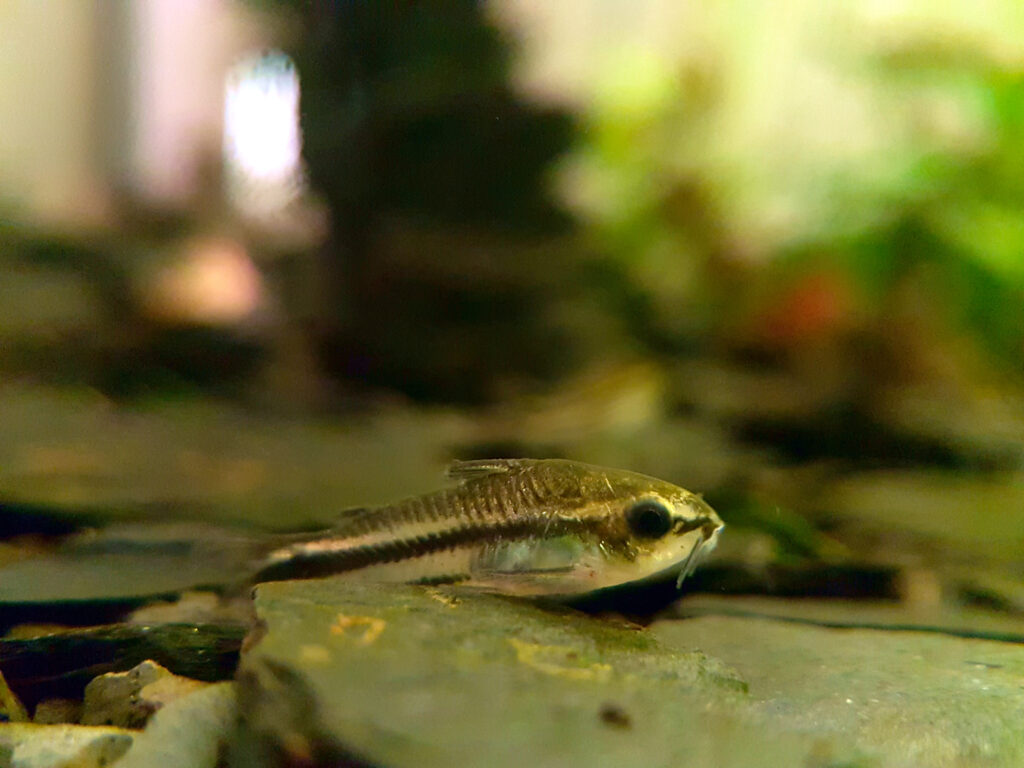
Pygmy Corydoras are an adorable and peaceful bottom-dwelling species that complement Dwarf Pencilfish nicely. These tiny catfish are active foragers, scouring the substrate for leftover food and debris. Pygmy Corydoras are social fish that should be kept in groups of at least six individuals.
| Common/Market Names | Pygmy Cory |
| Price Range | $2 – $4 per fish |
| Care Level | Easy |
| Behavior | Peaceful, bottom-dwelling |
| Life Span | 3-5 years |
| Max Size | 1 inch (2.5 cm) |
5. Ember Tetras (Hyphessobrycon amandae)
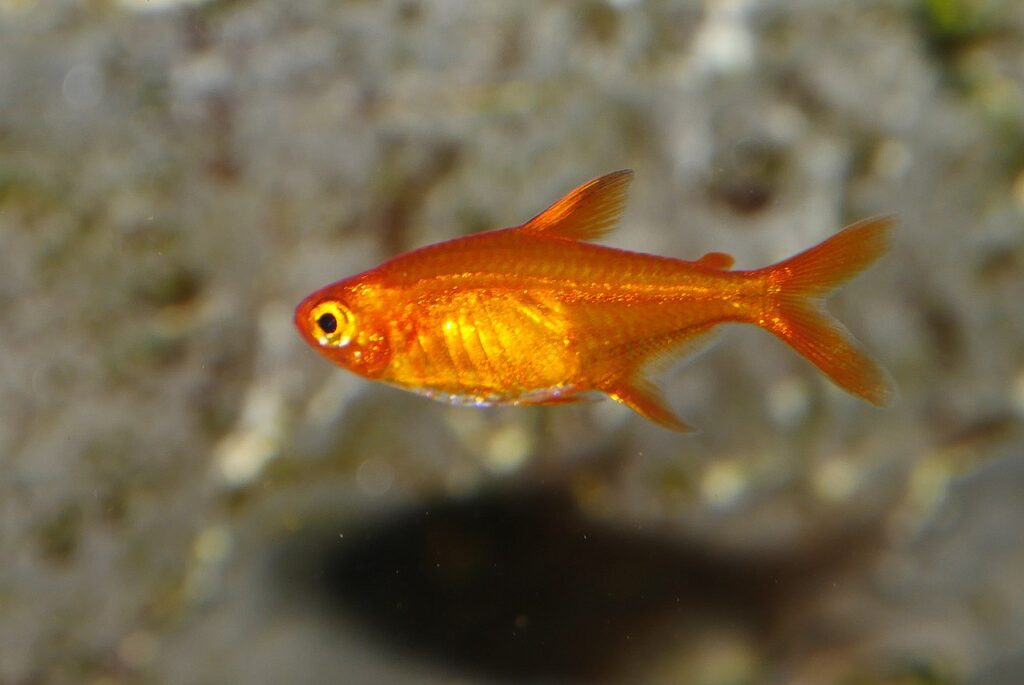
Ember Tetras are a vibrant, red-orange species that add a fiery splash of color to the aquarium. These peaceful, schooling fish are well-suited to life with Dwarf Pencilfish, as they occupy similar swimming zones and have comparable temperaments. Ember Tetras are active and hardy, making them an excellent choice for beginner aquarists.
| Common/Market Names | Ember Tetra |
| Price Range | $2 – $4 per fish |
| Care Level | Easy |
| Behavior | Peaceful, schooling |
| Life Span | 3-5 years |
| Max Size | 0.8 inches (2 cm) |
6. Celestial Pearl Danios (Danio margaritatus)
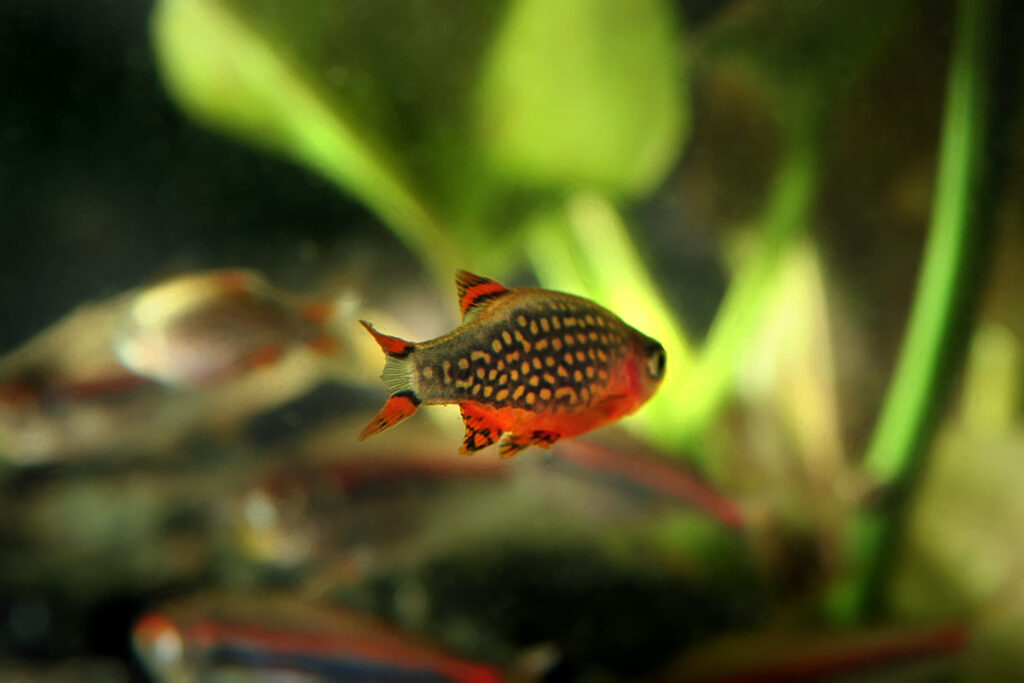
Celestial Pearl Danios, also known as Galaxy Rasboras, are a stunning and diminutive species that make excellent tank mates for Dwarf Pencilfish. These tiny fish are adorned with a galaxy-like pattern of spots and thrive in planted aquariums with gentle water flow. Celestial Pearl Danios are peaceful, active, and best kept in schools of at least six individuals.
| Common/Market Names | Celestial Pearl Danio, Galaxy Rasbora |
| Price Range | $4 – $7 per fish |
| Care Level | Moderate |
| Behavior | Peaceful, active |
| Life Span | 3-5 years |
| Max Size | 1 inch (2.5 cm) |
7. Chili Rasboras (Boraras brigittae)
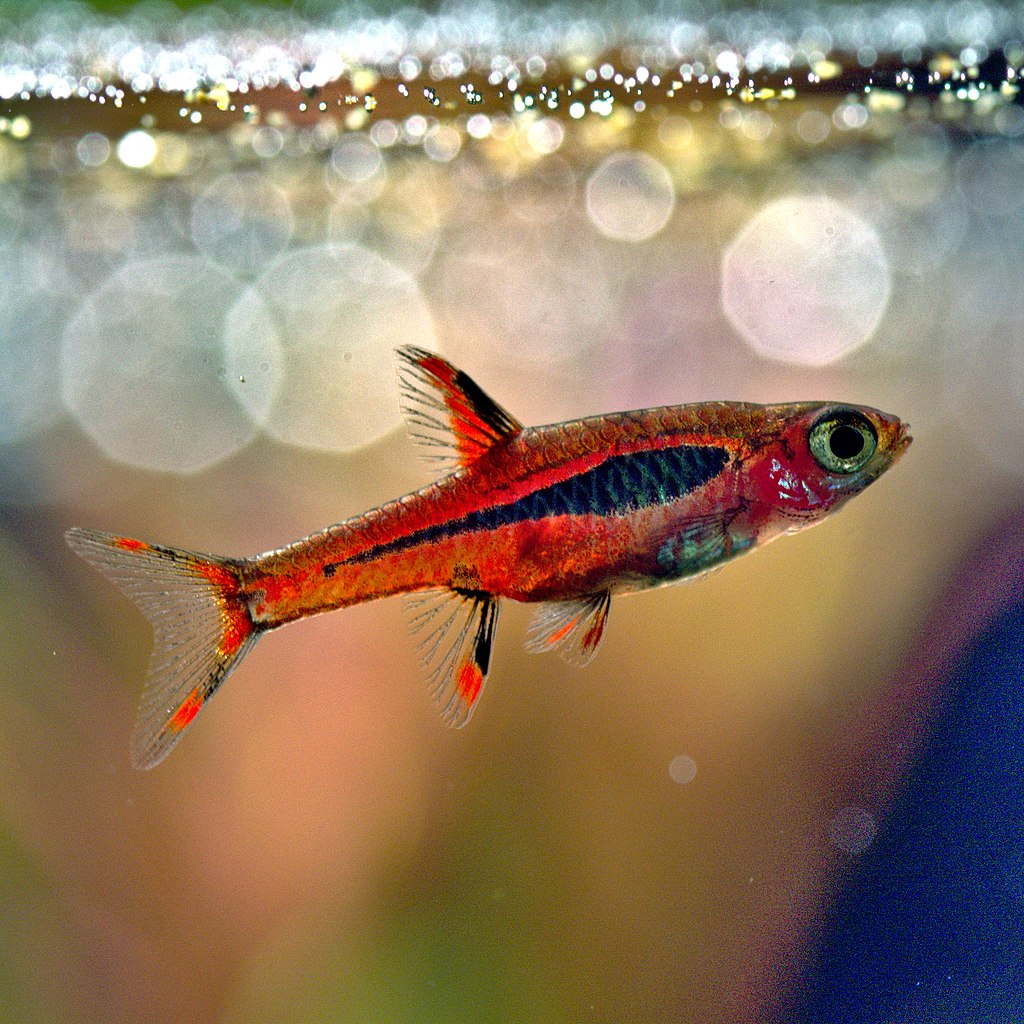
Chili Rasboras are a vibrant, red-colored micro fish that make stunning tank mates for Dwarf Pencilfish. These tiny, peaceful fish are active swimmers that thrive in heavily planted aquariums with gentle water flow. Chili Rasboras are schooling fish that should be kept in groups of at least eight to ten individuals.
| Common/Market Names | Chili Rasbora, Mosquito Rasbora |
| Price Range | $2 – $4 per fish |
| Care Level | Moderate |
| Behavior | Peaceful, schooling |
| Life Span | 3-5 years |
| Max Size | 0.7 inches (1.8 cm) |
8. Green Neon Tetras (Paracheirodon simulans)
Green Neon Tetras are a lesser-known cousin of the popular Neon Tetra, sporting a vibrant green stripe along their body. These peaceful, schooling fish make excellent tank mates for Dwarf Pencilfish, as they share similar water requirements and swimming habits. Green Neon Tetras are active and hardy, adapting well to a variety of aquarium conditions.
| Common/Market Names | Green Neon Tetra |
| Price Range | $2 – $4 per fish |
| Care Level | Easy |
| Behavior | Peaceful, schooling |
| Life Span | 3-5 years |
| Max Size | 1.5 inches (3.8 cm) |
9. Endler’s Livebearers (Poecilia wingei)
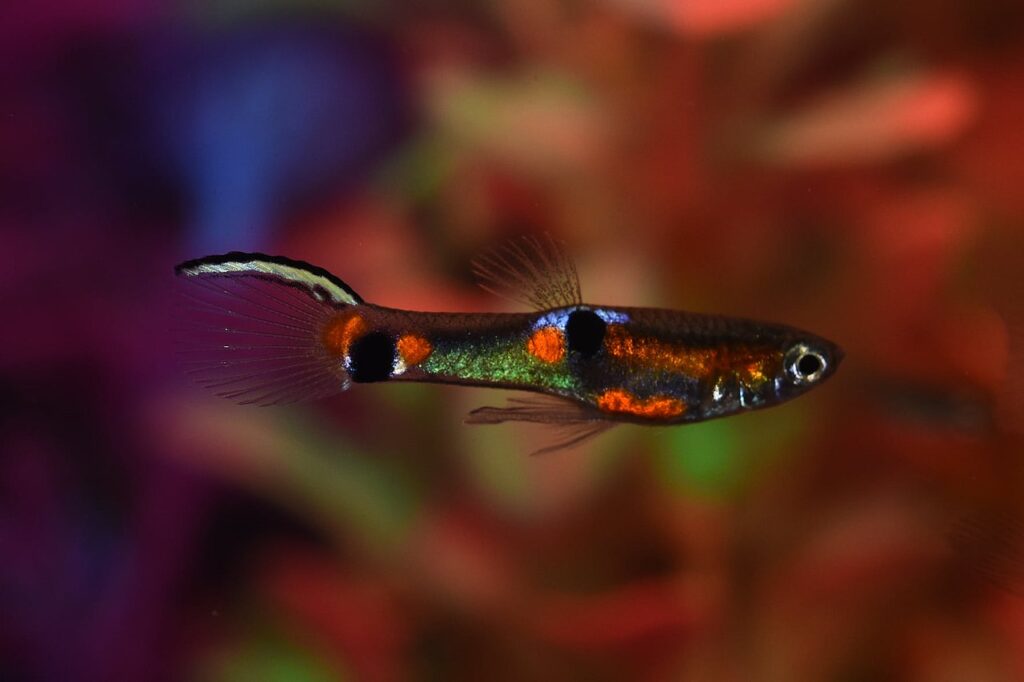
Endler’s Livebearers are a colorful and lively species that make great tank mates for Dwarf Pencilfish. These small, peaceful fish are active swimmers that occupy the upper levels of the aquarium. Endler’s Livebearers are hardy, adaptable, and easy to care for, making them an excellent choice for beginner aquarists.
| Common/Market Names | Endler’s Livebearer, Endler’s Guppy |
| Price Range | $2 – $5 per fish |
| Care Level | Easy |
| Behavior | Peaceful, active |
| Life Span | 2-3 years |
| Max Size | 1.5 inches (3.8 cm) |
10. Dwarf Corydoras (Corydoras hastatus)
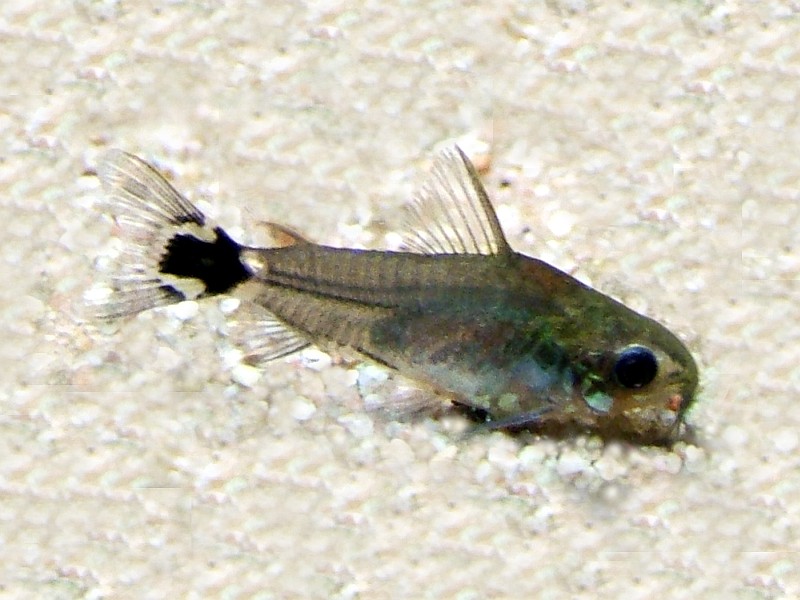
Dwarf Corydoras are another tiny, bottom-dwelling species that make fantastic tank mates for Dwarf Pencilfish. These peaceful catfish are active foragers, helping to keep the substrate clean and free of debris. Dwarf Corydoras are social fish that should be kept in groups of at least six individuals.
| Common/Market Names | Dwarf Cory, Tail Spot Cory |
| Price Range | $2 – $4 per fish |
| Care Level | Easy |
| Behavior | Peaceful, bottom-dwelling |
| Life Span | 3-5 years |
| Max Size | 1.25 inches (3.2 cm) |
These ten species make excellent tank mates for Dwarf Pencilfish, contributing to a peaceful, diverse, and visually stunning community aquarium. When selecting tank mates, always consider the compatibility of temperament, water requirements, and swimming habits to ensure a harmonious and thriving aquatic environment.
FAQs about Dwarf Pencilfish
How many Dwarf Pencilfish should I keep in my aquarium?
Dwarf Pencilfish are schooling fish and should be kept in groups of at least six individuals. Keeping them in larger numbers will help them feel more secure and display their natural behaviors.
Can Dwarf Pencilfish be kept with shrimp?
Yes, Dwarf Pencilfish are generally peaceful and can be kept with small, non-aggressive shrimp species such as Cherry Shrimp, Amano Shrimp, or Red Rili Shrimp. However, it’s essential to provide plenty of hiding spots and vegetation for the shrimp to feel secure.
Are Dwarf Pencilfish difficult to breed?
Breeding Dwarf Pencilfish can be challenging but not impossible. They require specific water conditions, including soft, acidic water and the presence of fine-leaved plants for spawning. Providing a separate breeding tank with the proper setup can increase the chances of successful breeding.
How often should I feed my Dwarf Pencilfish?
Dwarf Pencilfish should be fed small amounts of food two to three times a day. Offer a varied diet consisting of high-quality flake or pellet food, along with occasional treats of frozen or live foods like brine shrimp or daphnia.
Are Dwarf Pencilfish jumpers?
Yes, Dwarf Pencilfish are known to be jumpers, especially when startled or stressed. To prevent them from jumping out of the aquarium, make sure to keep a tight-fitting lid on your tank.
Can Dwarf Pencilfish be kept in a planted aquarium?
Absolutely! Dwarf Pencilfish thrive in heavily planted aquariums that mimic their natural habitat. Plants provide hiding spots, help maintain water quality, and create a visually appealing environment for these tiny fish.
How often should I perform water changes for my Dwarf Pencilfish tank?
Perform weekly water changes of 10-20% to maintain good water quality. Regular water changes help remove accumulated waste, replenish essential minerals, and keep your Dwarf Pencilfish healthy.
Are Dwarf Pencilfish sensitive to water parameters?
Dwarf Pencilfish are relatively hardy but do best in stable water conditions. They prefer soft, slightly acidic water with a temperature range of 72-79°F (22-26°C) and a pH between 6.0 and 7.5. Avoid sudden changes in water parameters, as this can stress the fish.
Can Dwarf Pencilfish be kept with bettas?
While it’s generally not recommended to keep Dwarf Pencilfish with bettas, it may be possible in larger, heavily planted tanks with plenty of hiding spots. However, the success of this combination largely depends on the individual temperament of the betta. It’s crucial to monitor their interactions closely and be prepared to separate them if necessary.
How can I tell if my Dwarf Pencilfish are healthy?
Healthy Dwarf Pencilfish should have vibrant colors, clear eyes, and no visible signs of disease or injury. They should be active swimmers, schooling together, and readily accepting food. If you notice any changes in appearance or behavior, it may indicate an underlying health issue that requires attention.